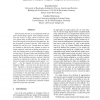Free Online Productivity Tools
i2Speak
i2Symbol
i2OCR
iTex2Img
iWeb2Print
iWeb2Shot
i2Type
iPdf2Split
iPdf2Merge
i2Bopomofo
i2Arabic
i2Style
i2Image
i2PDF
iLatex2Rtf
Sci2ools
89
Voted
ICPR
2008
IEEE
2008
IEEE
Qualitative analysis of spatio-temporal event detectors
Interest point detection is an established method to select relevent image regions. Such techniques use features like corners or edges, which are known to indicate regions likely to hold patterns of interest. Selection of such regions increases processing efficiency. For the recognition of motion, however, such context-free methods are still very rare. Though there are numerous methods to find space-time volumes of motion in image sequences, most aim at finding just motion as a such, not volumes which are more promising for analysis than others. Therefore Laptev and Lindeberg (2005) generalized the Harris detector to the spatio-temporal domain. But the problem remains to evaluate what kind of motion is captured by a detector. For example, the detector of Laptev and Lindeberg should capture “corners” — like the original 2D-version of Harris and Stephens (1988) — but what does that mean for motion? Therefore we present an approach to visualize events which were selected by a ...
| Added | 30 May 2010 |
| Updated | 30 May 2010 |
| Type | Conference |
| Year | 2008 |
| Where | ICPR |
| Authors | Benedikt Kaiser, Gunther Heidemann |
Comments (0)

